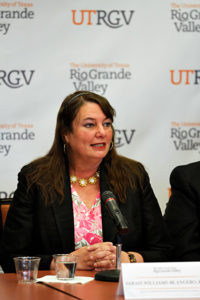Kaye/Bassman Academic Medicine Practice leads the search for New UTRGV Medical School
Kaye/Bassman Academic Medicine Practice leads the search effort for the placement of the inaugural South Texas Diabetes & Obesity Institute. Dr. Sarah Williams-Blangero, the institute’s first director came from Texas Biomedical Research Institute where she most recently served as the Chair, Department of Genetics as well as the Deputy Director, Southwest National Primate Research Center. Dr. Williams-Blangero built a team of 22+ PhD and Masters level scientists who will make a significant positive impact on health issues locally, regionally and worldwide the education of medical students as well as their own research.
UTRGV medical school continues progressing
Originally Posted: January 4, 2015 by ExpressNews.com – Aaron Nelsen
HARLINGEN — These are heady times in the Rio Grande Valley medical community. With the building of a new medical program underway, professionals in that field here have been busily stitching together the blueprint for a rigorous education that also reflects the specific health concerns of the border region.
“Our focus is to get credentialed,” said Dr. Francisco Fernandez, the founding dean of the University of Texas Rio Grande Valley School of Medicine. “Without that, everything else is just talk.”
While attention has centered on accreditation — an application was submitted to the Liaison Committee for Medical Education last month — the announcement of the South Texas Diabetes & Obesity Institute in October offers a window into the unique opportunities the medical school could provide.
The institute is designed to advance research of diabetes and obesity at the genetic level, and in a region where nearly 30 percent of the population suffers from diabetes and $720 million is spent every year on diabetes-related problems, the institute could prove a testing ground for diabetes treatment.
“The calls have already been coming in from Mexico, Dubai and beyond, interested in what we’re doing,” Fernandez said. “If you can make this work here, is it generalizable for the problems of diabetes statewide, and countrywide and global?”
The institute got a boost in mid-December, when H-E-B gave $1 million to UTRGV to help establish an endowed chair, said Dr. Sarah Williams-Blangero, the institute’s first director.
Within a few weeks, the institute will boast two dozen researchers from the University of Texas Health Science Center in San Antonio and the Texas Biomedical Research Institute, where Williams-Blangero had been chairwoman of the genetics department. Institute research staff will transfer ongoing projects to the Valley and dedicate a portion of their time to teaching.
“The research would be conducted with and have relevance for the local population,” Williams-Blangero said. “It will be a nice, full circle in terms of research, research outcomes and applying those research outcomes.”
Those research projects will provide training opportunities for students to work with researchers as well as to pursue their own research interests, especially in the genetics of common complex diseases and familial factors that influence susceptibility to disease and intervention studies.
“This is a really exciting time,” Williams-Blangero said. “This medical school has a chance to be on the cutting edge.”
In 2013, the Legislature created UTRGV, which merged resources and assets of the University of Texas at Brownsville and the University of Texas Pan American in Edinburg. The move was widely praised because it gave a single regional university access to the Permanent University Fund for the first time, and it made the development of a medical school possible.
While the new university presents educational opportunities that have the potential to transform the local workforce, disparities for students on the border remain a significant obstacle for education attainment, said Dr. Nolan Perez, a gastroenterologist in Harlingen and a member of the UTRGV School of Medicine advisory committee.
“It’s critically important that we develop curriculum alignment with what we’re doing in the public schools,” Perez said. “Trust me, the UT system is going to create a top-notch, clinically sound, research-intensive medical school. What a travesty it would be if we did not create a robust pipeline of local students.”
The medical school will admit at most 50 students, but first it must pass a preliminary review before it can even begin recruiting students in 2015, let alone matriculate them in the summer of 2016. For more than a decade, third- and fourth-year medical students have completed a portion of their clinical training in the Valley through the Regional Academic Health Center in Harlingen, part of the University of Texas Health Science Center at San Antonio.
“We want to make sure we have the ability, if we train someone here, to offer postgraduate training,” Fernandez said. “Because studies have shown if somebody does their medical training and residency in the same place, nearly three-quarters of them will stay.”
But before then, the school must establish a curriculum for several core areas of medicine and recruit faculty and department heads for internal medicine, surgery, family medicine, obstetrics and gynecology.
“On the one hand, somebody could say, ‘Oh my god, you didn’t run away from that job?’” Fernandez quipped. “At the same time, the challenges are such an amazing collection of opportunities.”
anelsen@express-news.net
Aaron Nelsen
Rio Grande Valley Bureau | San Antonio Express-News

